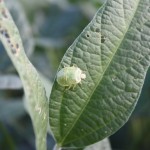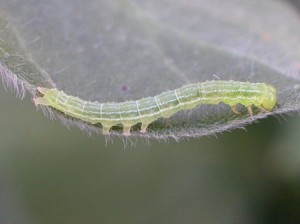The primary call this week has been about whether to treat for threecornered alfalfa hoppers or not. Reports of 1-3 hoppers per sweep are pretty common. The short answer is NOT to treat for threecornered alfalfa hoppers, and I will refer you to an article from last week.

It is too easy to forget about stink bugs as we wrap up the cotton crop and are busy harvesting corn. Stink bug populations are on a steady rise in many soybean fields. I’ve observed or had reports of several fields at or above the suggested treatment threshold of 9 or more stink bugs per 25 sweeps. These fields are typically at the R5-R6 growth stage.
It looks like we have mostly dodged problems with corn earworm but we need to remain alert, especially in our latest maturing fields because moth trap catches remain relatively high in some areas. The two common caterpillars being observed are green cloverworm and loopers (cabbage or soybean). Few fields need treatment at this time, but this can change quickly. It is important to distinguish between green cloverworm and soybean looper. Soybean loopers are more difficult to control with insecticides, and the treatment threshold is also lower for loopers (19/25 sweeps) vs. green cloverworms (38/25 sweeps). Below are some characteristics and pictures to help distinguish the species. Both loopers and small green cloverworms often “loop” in inch-worm fashion, so this is not a great way to tell them apart.
Green Cloverworm – three pairs of prolegs and the is body about the same width from head to tail. They often wriggle violently when touched or handled.
Loopers – two pair of prolegs and the head end is narrower than the tail. As a general rule, loopers with black true legs or black spots on the body are soybean loopers. Those without black markings may be either soybean or cabbage loopers. This can be important because soybean loopers are resistant to pyrethroid insecticides. During late season, it is common to have a mixed bag that includes mostly soybean loopers, and this is the safest assumption when choosing an insecticide (see below).

Insecticide Selection: Green cloverworms are relatively easy to control with mid-rates of pyrethroid insecticides such as Brigade or other bifenthrin products, Baythroid XL, Declare, Karate or Mustang Max. Products typically used for soybean looper, such as Intrepid (4-6 oz), Belt SC (1.5-2 oz), Steward (6-9 oz) or Tracer (1.5-2 oz), will also control green cloverworm. Do not use a pyrethroid insecticide if your primary target is soybean loopers.
There is often a mixed bag of defoliators that may include several species of caterpillars, bean leaf beetles, blister beetles and other species. Treatment is recommended if defoliation exceeds 20-25% anytime between R1-R6.
Not to cast any further shadows, but fall armyworm are currently a threat. Beet armyworm and soybean loopers are also looming as potential problems. Please see the comments in the related article. Scout your soybean fields at least weekly from this point forward!



One thought on “Soybean Insect Update”
Comments are closed.